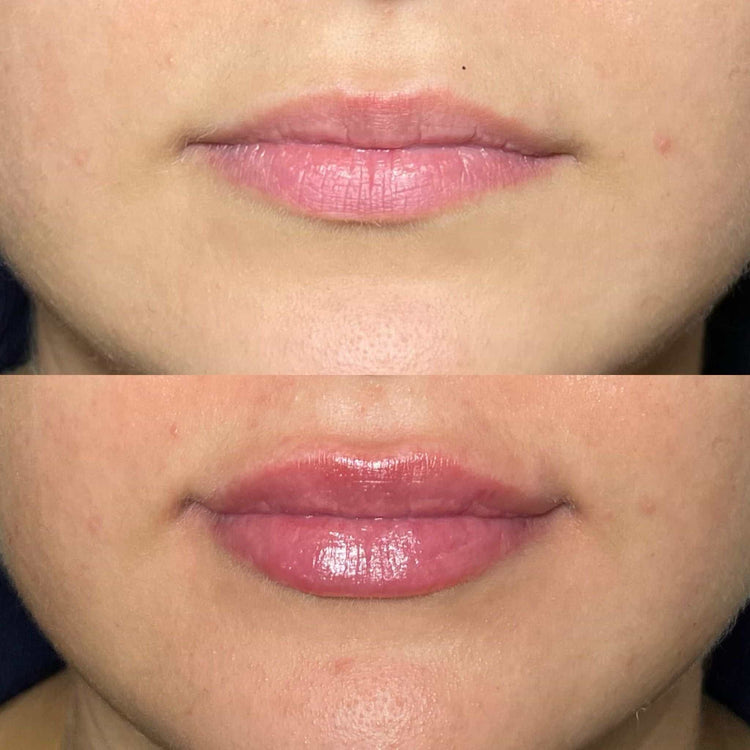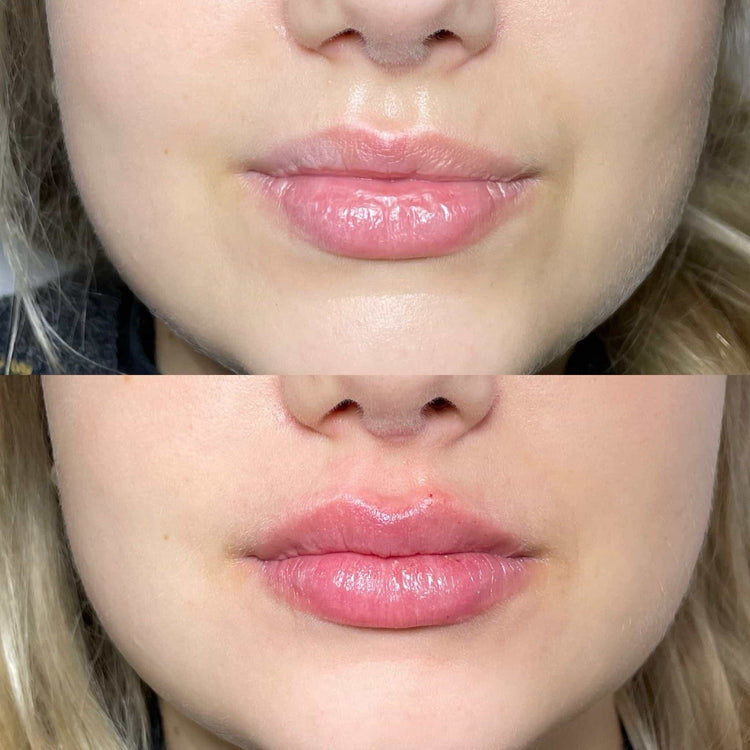Understanding Lip Fillers
Want fuller, more symmetrical lips but unsure if fillers are the right solution? Understanding how lip fillers work and their limitations can help you make an informed decision about whether they’re suitable for correcting unevenness.
What are lip fillers?
Lip fillers are injectable substances designed to add volume and shape to the lips. They typically contain hyaluronic acid, a natural substance found in the body that attracts and retains moisture. This gel-like consistency allows it to plump up the lips while providing hydration.
Lip fillers can be used to address a variety of concerns, including:
- Increasing lip size
- Correcting asymmetry
- Defining the cupid’s bow
- Smoothing out wrinkles around the mouth
Types of lip fillers
Lip fillers can be effective in correcting uneven lips, but it’s important to understand the limitations. They work by adding volume and smoothing out contours, effectively minimizing the appearance of asymmetry. However, fillers won’t address underlying structural differences in the lips.
There are different types of lip fillers available, each with its own characteristics and suitability for specific concerns:
- Hyaluronic Acid Fillers: These are the most common type, providing a natural-looking enhancement with subtle volume. They are temporary, typically lasting 6-18 months.
- Collagen Fillers: While less common now, collagen fillers offer immediate results but tend to be short-lasting (a few weeks).
- Poly-L Lactic Acid (PLLA) Fillers: These stimulate collagen production over time, gradually increasing lip volume for a more long-term result.
How Lip Fillers Correct Uneven Lips
Lip fillers offer a solution for those seeking symmetrical and full lips. These injectable substances, primarily hyaluronic acid-based, add volume and definition to the lips, smoothing out contours and minimizing the appearance of asymmetry.
Identifying unevenness
Unevenness in lips can manifest in various ways. One common issue is an imbalance in lip size, where one lip appears larger than the other. Another concern is asymmetry in the shape of the Cupid’s bow, the dip in the center of the upper lip. Some individuals may also have uneven fullness along the border of their lips, creating a less symmetrical appearance.
The process of filler application
The process of applying lip fillers typically begins with numbing the area with a topical anesthetic cream. Once numbed, the practitioner will inject small amounts of filler strategically into various points of the lips.
Depending on the desired outcome, filler may be injected along the borders to define the shape, in the center of the lips to add volume, or at specific points to correct asymmetry. The practitioner uses a cannula (a thin, blunt-tipped tube) or syringe with a very fine needle for precise placement.
After the injection, the practitioner may massage the area gently to ensure even distribution of the filler and minimize any bruising or swelling.
Techniques for addressing different types of asymmetry
Lip fillers can effectively address various types of asymmetry. For instance, if one lip is larger than the other, the practitioner will inject more filler into the smaller lip to balance the proportions.
To correct an uneven Cupid’s bow, filler is strategically placed in the dip of the upper lip to create a smoother and more symmetrical arch.
Uneven fullness along the border of the lips can be addressed by injecting filler along the outer edge, creating a more defined and balanced appearance.
Things to Consider Before Getting Lip Fillers
Thinking about getting lip fillers? Understanding how they work and what they can realistically achieve is essential before making a decision.
Consultation with a qualified practitioner
Lip fillers are a popular option for enhancing the lips, but it’s important to understand their limitations before making a decision.
A consultation with a qualified practitioner is crucial. During this appointment, discuss your desired outcome and any concerns you have about unevenness in your lips. The practitioner will assess your lip structure, facial symmetry, and skin type to determine if fillers are suitable for you and create a personalized treatment plan.

- Evaluate your expectations realistically. Lip fillers can minimize the appearance of asymmetry but won’t completely eliminate it if there are underlying structural differences in the lips.
- Discuss your medical history. Inform the practitioner about any allergies, medications you take, or previous cosmetic procedures you’ve had.
- Ask about different types of fillers. There are various options available, each with different properties and longevity. The practitioner can recommend the most suitable type for your needs.
- Inquire about potential side effects and risks.
- Understand the costs involved. Lip filler treatment costs vary depending on factors like the amount of filler used and the practitioner’s expertise.
Remember, choosing a qualified and experienced practitioner is essential for safe and effective lip filler treatments.
Realistic expectations
Lip fillers can be an effective way to correct uneven lips, but it’s important to have realistic expectations. Lip fillers add volume and smooth out contours, minimizing the appearance of asymmetry, but they won’t completely eliminate structural differences in the lips.
- Consider what you want to achieve.
- Do your research and choose a qualified practitioner.
- Be aware of potential side effects.
Potential side effects and risks
Things to consider before getting lip fillers include evaluating your expectations realistically, as fillers can minimize unevenness but not completely correct underlying structural differences. Research different types of fillers and their characteristics to determine which is best suited for your needs. It’s crucial to discuss your medical history with the practitioner and inquire about potential side effects and risks.
Potential side effects of lip fillers can include swelling, redness, bruising, tenderness, and itching at the injection site. These are usually temporary and subside within a few days. More serious, but less common, side effects can include infection, allergic reactions, or changes in lip shape or volume if fillers are not injected correctly.
To minimize risks, it’s essential to choose a qualified and experienced practitioner who uses sterile techniques and appropriate products.
Aftercare Instructions
Aftercare instructions are crucial for ensuring optimal results and minimizing potential complications after any cosmetic procedure, including lip filler treatments.

Initial recovery period
Following your lip filler treatment, it is important to take steps to ensure proper healing and minimize the risk of complications.
Avoid touching or picking at the treated area to prevent infection and swelling.
Apply ice packs for 10-15 minutes at a time, several times a day, to reduce swelling and discomfort.
You may experience some bruising or tenderness, which should subside within a few days. If swelling persists or worsens, contact your practitioner.
Refrain from consuming alcohol or using blood-thinning medications for a few days after the procedure as these can increase the risk of bleeding and bruising.
Do not engage in strenuous activities that may put pressure on your lips for at least a week.
Use lip balm regularly to keep the treated area hydrated.
Avoid direct sun exposure and use sunscreen with an SPF of 30 or higher on the treated area to prevent discoloration.
Attend any scheduled follow-up appointments with your practitioner to monitor your progress and address any concerns.
The initial recovery period after lip filler treatment typically lasts 1-2 weeks.
During this time, you may experience some swelling, bruising, and tenderness which will gradually subside. You can resume most of your normal activities within a few days, but avoid strenuous exercise or activities that put pressure on your lips for about a week.
It’s important to follow your practitioner’s aftercare instructions carefully to ensure optimal healing and minimize the risk of complications.
Long-term maintenance
Aftercare is crucial for ensuring proper healing and minimizing risks associated with lip fillers. Avoid touching or picking at the treated area to prevent infection and swelling. Apply ice packs for 10-15 minutes at a time, several times a day, to reduce swelling and discomfort.
Refrain from consuming alcohol or using blood-thinning medications for a few days after the procedure as these can increase the risk of bleeding and bruising. Avoid direct sun exposure and use sunscreen with an SPF of 30 or higher on the treated area to prevent discoloration. Attend any scheduled follow-up appointments with your practitioner to monitor your progress and address any concerns.
Lip fillers are typically temporary, lasting 6-18 months depending on the type of filler used and individual factors.
Long-term maintenance involves repeat treatments to maintain the desired lip volume and shape as the filler gradually breaks down. The frequency of repeat treatments will vary based on individual results and lifestyle factors.
It’s important to follow your practitioner’s recommendations for long-term maintenance and attend regular check-up appointments.
Touch-up appointments
Aftercare instructions are essential for ensuring proper healing and minimizing the risk of complications after lip filler treatment.
Avoid touching or picking at the treated area to prevent infection and swelling.
Apply ice packs for 10-15 minutes at a time, several times a day, to reduce swelling and discomfort.
You may experience some bruising or tenderness, which should subside within a few days. If swelling persists or worsens, contact your practitioner.
Refrain from consuming alcohol or using blood-thinning medications for a few days after the procedure as these can increase the risk of bleeding and bruising.
Do not engage in strenuous activities that may put pressure on your lips for at least a week.
Use lip balm regularly to keep the treated area hydrated.
Avoid direct sun exposure and use sunscreen with an SPF of 30 or higher on the treated area to prevent discoloration.
Attend any scheduled follow-up appointments with your practitioner to monitor your progress and address any concerns.
Touch-up appointments are often necessary to maintain the desired results of lip fillers.
As filler gradually breaks down over time, touch-ups can be done every 6-18 months depending on the type of filler used and individual factors.
During a touch-up appointment, your practitioner will assess the appearance of your lips and determine how much additional filler is needed to restore the desired volume and shape.
Find out how lip injections can boost your confidence with Dr. Laura Geige at It’s Me & You Clinic
